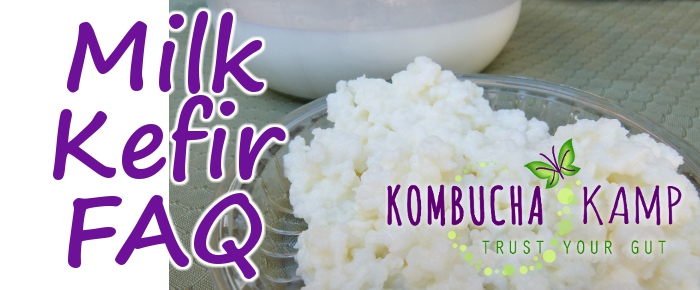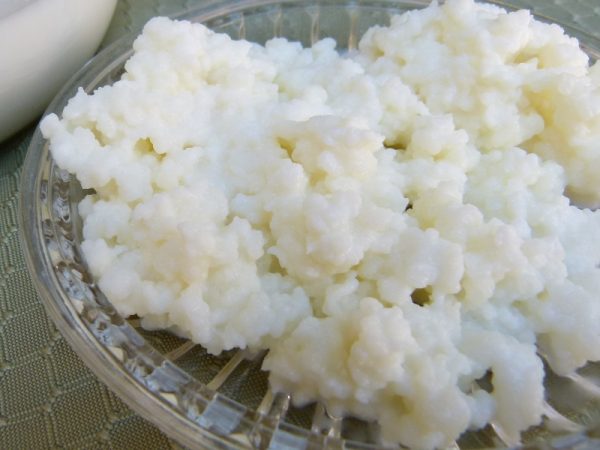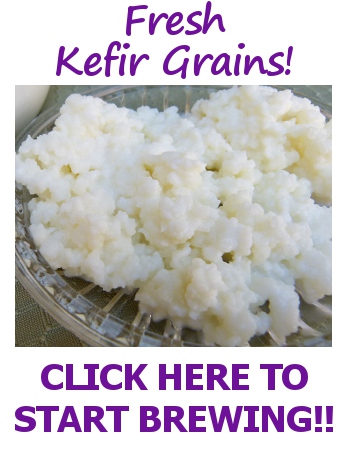Milk Kefir FAQ
Welcome to the Kombucha Kamp Milk Kefir FAQ, a great place to find answers to all your kefir questions. Can’t find your answer in our milk kefir faq? Try our Milk Kefir Recipe page or drop us a line via the Contact Page.

What Is Milk Kefir?
Milk kefir is the ORIGINAL kefir! It is a fermented drink made by adding milk kefir grains to dairy milk and allowing it to ferment for a couple of days depending on brewing temperature and taste preference. The resulting drink is a tangy, drinkable “yogurt” that makes a terrific base for smoothies or to enjoy on it’s own. You can also ferment a wide range of dairy and non-dairy milks with the grains.
How Do You Pronounce The Word Kefir?
The traditional way to pronounce “kefir” is “kuh-FEAR” with the emphasis on the second syllable. There are two other common pronunciations we hear in the United States. We say KEE-fur because words in English don’t typically stress the last syllable for nouns. KEFF-er is an alternate pronunciation because it is common for short vowel sounds to be represented by a single vowel. “Tomato” -“tomahto” as we say!
What Does Milk Kefir Taste Like?
Milk kefir is essentially cultured milk so it has a tangy flavor. In order to preserve the milk and prevent mold or other organisms from colonizing it, the healthy bacteria and yeast produce acids that give it a mildly tangy flavor. Many traditional terms for fermentation acknowledge this process by using “sour” as a verb. Some describe it as cheesy, yogurty or similar to creme fraiche – all of those are fermented dairy products so it would be appropriate to say that it tastes like fermented dairy! You can also flavor milk kefir, which opens up a wide range of options.
What Is The Difference Between Water Kefir And Milk Kefir?
Milk kefir is the “original kefir”. Made from milk, the fermentation process enhances the nutrient profile. Water kefir is a polysaccharide that thrives on sucrose. The process of making water and milk kefir is similar and both of the cultures are known as “grains”. However, that is where their similarity ends. Each comprise a unique and different
Why Is Milk Kefir Good For Health?
All fermented foods provide nutrients in a living form. At Kombucha Kamp, we recommend consuming a variety of fermented foods and drinks to provide a wide range of real nutrition for a good gut. If the body has what it needs to thrive, as a result it can keep you healthy!
Is Kefir Healthier Than Yogurt?
Traditionally fermented kefir and yogurt are both more nutrient dense and have a greater microbial diversity than their commercially produced counterparts. However, since kefir doesn’t require heat to induce fermentation, a greater diversity of organisms are typically able to proliferate compared to yogurt.
Where Do Milk Kefir Grains Come From?
Milk kefir grains originate in the Caucasus Mountains which are located on the isthmus between the Black and Caspian Seas and co-located in the countries of Georgia, Azerbaijan and Russia. They are purported to have been a gift from the Prophet Mohammed to the Orthodox believers and the culturing methods were kept a secret for hundreds of years. Originally fermented in bags made from animal stomachs, they hung near the door and passerbys would give it a tap to stir the mixture and for good luck. Kefir grains were so highly prized that they were handed down as part of a woman’s dowry to ensure the health and vitality of the family.
What are some other names for milk kefir?
Fermentation cultures have nearly as many different names as they have strains of organisms! Here are some of milk kefir’s other names:
The Grains of The Prophet Muhammad, The Drink of the Prophet, Snow Lotus, Keefir, Kephir, Kefyras, Knapon, Kepi, Kippe, Mudu Kekiya, Búlgaros, Tara, Yogurt Plant, Yogurt Mushroom, Tibetanischer Pilz (German), Alga Galodium and Yoghurt de Pajaritos.
What Do Milk Kefir Grains Look Like?
Milk kefir grains may look like small white balls that are stuck together to form what looks like cauliflower. The polysaccharide is the structure that houses the bacteria and yeast. Grains vary in color from white to slight yellow. Avoid grains that are pink or have other colors as they may be contaminated.
How Much Milk Kefir Grains Do You Need?
Milk kefir grains can change shape in response to the type of milk being used. For example, if the grains are moved from pasteurized milk to raw milk, they often take on a looser and thinner texture. Temperature will also change the shape of milk kefir grains. Storing them in the refrigerator causes the grains to shrink and eventually fall apart.
Is It Possible To Use Too Many Milk Kefir Grains?
Too many kefir grains simply causes the milk to convert more quickly. This is evidenced by the formation of whey (clear liquid) which separates from the white part of the milk. If you have too many grains, pop them in a smoothie, give them to friends, feed them to pets or increase the size of your batch!
Are Milk Kefir Grains Reusable?
Milk kefir grains are infinitely reusable provided they are healthy and active. If they go dormant, it may take a few cycles for them to fully revive. The interim kefir tends to be thinner than usual but will thicken up again once the grains are fully nourished.
What’s The Difference Between Milk Kefir Grains And Powdered Milk Kefir Starter?
Powdered milk kefir starters are less diverse than living grains because some of the organisms die in the dehydration process. Plus powder never creates living grains that can replicate on their own. On the other hand, living grains are robust and hardy with terrific microbial diversity when well maintained.
Do Milk Kefir Grains Change Shape?
You will need 1 tablespoon of milk kefir grains to ferment 1 pint of milk kefir. You may scale the ratio depending on what size batch of milk kefir you want to make.
Do Milk Kefir Grains Multiply?
Yes! Milk kefir grains are very prolific provided they have the right environment to thrive. They prefer 65-75°F (18-24°C) (on the warmer side for reproducing usually), and to be fed every 24 hours. A pinch of white sugar can help speed the process along especially at cooler temps.
How Fast Do Milk Kefir Grains Grow?
Milk kefir grains plump and reproduce rapidly when they are fed consistently (they love daily feeding) and maintained at the proper temperature. If they are stored in the fridge between uses, expect them to need some time to “wake up” from the colder temps. Dehydrated grains, while they can be used to make milk kefir, will likely never reproduce again.
Do You Have To Feed Milk Kefir Grains Every Day?
Milk kefir grains prefer to feed every 24-48 hours. It may be possible to leave them at room temperature for 3-4 days once in awhile. However, if not fed regularly, the grains will disintegrate as the organisms will literally eat the nutrients holding them together.
Is It Okay To Cut, Chop, Or Blend Milk Kefir Grains?
Yes! Drop your extra grains into your smoothie or pop right in your mouth like a sour probiotic gummy bear!

Should I Rinse My Milk Kefir Grains?
Typically it is not recommended to rinse fermentation cultures unless they show signs of imbalance (ie excess yeast) as doing so may expose them to chlorine or rinse away some of the vital organisms resulting in a weaker culture. If rinsing is needed, we’d advise doing so gently in milk rather than with water.
Do Milk Kefir Grains Need To Rest?
No! They guys are always hungry so keep them happy and well fed and they will yield a lifetime supply!
Can I Use Milk Kefir Grains That Fell Into The Sink Or On The Floor?
Fermentation cultures are complex systems of numerous organisms which makes them impervious to mold when cared for correctly. Incidental and brief contact with the sink or floor is unlikely to contaminate them. However, if you have plenty, then it’s okay to let them go.
Can I Make My Own Milk Grains From Other Ingredients?
Although researchers have tried, none have been successful in replicating the kefir grain in a lab. This is likely due to the unique and complex microbial diversity they house in their polysaccharide structure.
Can I Use My Milk Kefir Grains To Make Water Kefir?
You know the old saying…”once you go water kefir, you can never go back” that’s because if you ferment the milk kefir grains without lactose, it will kill off the organisms that thrive on that substrate. So over time, you may be able to encourage the grains to proliferate on straight sugar (or other sugar source) but they can’t then be used to make milk kefir again. And they would not be the same as other water kefir grains.
How Do You Make Milk Kefir?
Milk kefir is very easy to make. Simply add 1 tablespoon of living milk kefir grains to 2 cups of whole milk. Cover with a cloth or lid and store at room temperature. After 24-48 hours, harvest the drink and then put into bottles with flavoring (if desired), pop into smoothies or use in place of buttermilk!
What Supplies Do You Need To Make Milk Kefir?
You probably have all of the supplies you need lurking in your kitchen cupboard.
- Milk kefir grains
- Quart sized or half gallon jar
- Cloth cover or plastic lid
- Strainer (can be stainless steel or plastic) or cheesecloth
Do I Have To Use Organic Ingredients When Making Milk Kefir?
When it comes to putting nutrients in your body, it definitely makes a difference if those food sources are contaminated with pesticides. So ideally, organic ingredients are our first choice. Of course, if all that is available is conventional milk, rest assured that the fermentation process will also help reduce any potential toxins present in the milk. Knowing the source of your ingredients is the surest way to maintain peace of mind.
What Type Of Container Is Best For Fermenting Milk Kefir?
Milk kefir ferments best in glass, 304/316 stainless steel, or fermentation safe porcelain. Food grade plastic may also be used but constant or frequent exposure to the acidity of the kefir may cause it to degrade over time.
How Long Can You Let Milk Kefir Ferment?
The grains need to be fed frequently because if not they will disintegrate. We recommend 24-48 hours for the first fermentation. The kefir will separate into curds and whey. We have found the best flavor is right before the separation occurs. The time needed will vary based on your environment.
What Temperature Does Milk Kefir Prefer?
Milk kefir prefers temperatures of 65-75°F (18-24°C). Using a thermometer strip will help keep track of the temperature and sometimes they will need a heat source especially in colder months to help them ferment and proliferate.
Should I Use A Lid Or Cloth Cover With Milk Kefir?
You can use either a lid or cloth cover to ferment the milk kefir. We’ve done it both ways and don’t detect a noticeable difference between the two. Most important is to just keep bugs out.
What Kind Of Milk Is Best For Milk Kefir?
Organic whole, pasteurized milk is our recommendation as it is affordable and easy to source. Whole milk is important because fat is a vital nutrient for the grains (and humans!). Raw milk, other types of dairy milks, and non-dairy milks may also be used to achieve different flavors and health benefits. But these other types of milk may require an adaptation period or special care for the grains to thrive over time.
I Can Only Find Ultra-Pasteurized Milk, Can I Still Use That?
Yes! While high temperature pasteurization may render beneficial enzymes and some vitamins naturally present inactive, it doesn’t damage the lactose aka milk sugar which is what the grains feed on. We recommend organic if possible or sourcing from a local dairy to ensure the highest quality milk kefir.
Can You Use Raw Milk For Making Kefir?
While you can use raw milk to make kefir, the live bacteria present may compete with the bacteria in the kefir grains. This can cause issues with flavor or consistency, especially at first. The grains will adapt over time to work with raw milk, just like other milks. However, because raw milk is often expensive to purchase, we recommend using high quality pasteurized milk instead. The milk kefir grains will add back the good bacteria to make it digestible.
Can You Use Low Fat Milk To Make Kefir?
It may be possible to use low fat milk once or twice to make kefir, but eventually the grains starve from lack of, well, fat! Low fat milk kefir is thinner and not as delicious in our opinion. If you decide to make low fat kefir, rest the grains in full fat milk or cream between batches or every other batch to refresh them.
Can You Use Almond Milk To Make Kefir?
Yes you can use a variety of nut milks. However, just as like with any change, the grains will require a period of adaptation. It may be possible for them to be able to survive on nut milk exclusively. Or, you may choose to refresh them in whole cows milk in between batches of almond milk kefir. This will give the grains new life and generally works better.
How Long Does Kefir Stay Good In The Fridge?
Kefir never stops fermenting, even after you remove the grains! As long as no mold shows on top of the liquid, it’s safe to drink. But the milk kefir can still get too sour to enjoy. Most people find that more than a few days at room temperature is long enough to reach that point. Storing milk kefir in the refrigerator usually allows it to remain drinkable for 1-3 weeks. If it’s been there longer, take a look and maybe a sniff. As long as it appears safe, you can take a small sip and see how it tastes. 🙂
What is the Ideal Fermenting Temperature?
Ferment times may vary depending on temperature, milk-to-grain ratio, and overall health of the grains.
| GRAINS | MILK | TEMPERATURE | FERMENT |
| 1 TBSP | 2 CUPS | over 78°F / 25°C | 1-2 days |
| 1 TBSP | 2 CUPS | 76-78°F / 24-25°C | 2-3 days |
| 1 TBSP | 2 CUPS | 70-75°F / 21-23°C | 3-4 days |
| 1 TBSP | 2 CUPS | 65-70°F / 18-21°C | 4-5 days |
| 1 TBSP | 2 CUPS | below 65°F / 18°C | 5+ days |
*Do not allow to ferment for more than 72 hours without proper milk to grain ratio. Grains will starve and eat themselves.
*Surface may turn yellow or brown caused by higher temperatures. Move to a cooler location or shorten ferment time.
Is Milk Kefir A Probiotic?
Yes milk kefir has a variety of live bacteria and yeast that are considered probiotic. The actual types and amounts will vary based on the grains and process. Traditionally, cultures used to make homemade kefir have more strains than commercial versions.
Is Kefir Good When You Have Diarrhea?
Kefir is not a medical treatment. However, many people have found it helps balance digestion and gut issues. But drinking kefir and the influx of bacteria and yeast for the first time may actually inspire some stomach reaction. That’s because all the good bugs are making room for themselves, which can inspire activity. So take it easy!
Is There Alcohol In Milk Kefir?
Milk kefir may contain trace amounts of alcohol, just as all fermented beverages do, but the amount is usually low, around .2% – .8% and not intoxicating.
Is There Lactose Left In Milk Kefir?
Milk kefir grains feed on lactose also known as milk sugar. Many people believe they are lactose intolerant because they can have an allergic reaction to consuming pasteurized milk. Often they are actually pasteurization intolerant because when the organisms in raw milk are permitted to proliferate, they break down the lactose which reduces the impact on the body.
Is There Protein In Kefir?
Yes! Kefir is an excellent source of protein. One cup of milk kefir can contain between 4 and 12 grams of protein. Whole milk provides the most protein in milk kefir.
Is There Gluten In Milk Kefir?
No! “Grain” is a term of convenience for the milk kefir polysaccharide rather than a literal description. Therefore it is naturally gluten free!
How Do You Use Milk Kefir As Buttermilk?
Milk kefir is delicious to drink but if you have extra or are looking for a buttermilk substitute that isn’t simply acidulated milk, then you can use your milk kefir in place of buttermilk in any recipe. Check out our recipe for Milk Kefir Pancakes. The natural souring that occurs adds lift and a tangy irresistible flavor!
How Do You Make Kefir Cheese From Milk Kefir?
After removing the grains from the kefir, fold a piece of cheesecloth and line it inside a strainer. Place the strainer in a pitcher or bowl and pour the milk kefir into the strainer. Allow the kefir to drain overnight, separating the clear liquid whey below. This may be left overnight covered or in the refrigerator. Once fully strained, the kefir cheese will be thick and can be stored for many weeks in the refrigerator in a closed container. You can also flavor kefir cheese. Grab your grains from Kombucha Kamp and receive a free copy of our “Lacto Fermented Sodas Guide” which includes a kefir cheese recipe along with many more tips for working with both milk & water kefir grains plus bonus recipes!
Can I Give My Dog Kefir? How Much Kefir Can I Give My Dog?
Yes! Dogs love kefir. But just like people, it’s best to take it slow. Try just a couple of teaspoons in one meal a day for a couple of days to see how they react. If all is well, alternate every other day or more as desired.
How Do You Store Milk Kefir Grains?
Milk kefir grains are like people in that they do not like it if you ignore them! They thrive when they are fed consistently. However, if you need to take a break, then store them in the fridge in some milk and change it out every 7 days to keep them fresh.
How Long Can You Store Milk Kefir Grains In The Fridge?
Milk kefir grains can be stored in the refrigerator. Cover the grains in milk and use a lid if available. By changing out the milk every 7 days, it is possible to keep the grains viable for many weeks. How long they will last depends on the temperature of the refrigerator and the health of the grains.
Can You Dehydrate Milk Kefir Grains For Storage?
Dehydrating milk kefir grains can sometimes work. As long as dehydrated grains produce kefir that does not mold, it is safe to drink. However, in most cases the kefir made by dehydrated grains is not as active or delicious. Additionally, dehydrated kefir grains generally do not reproduce anymore.
Can You Freeze Milk Kefir Grains?
Freezing kefir grains can sometimes work. The same as dehydrated grains, the kefir they make may not taste great and they may not reproduce. Add a small amount of milk to the grains prior to freezing and do so in a plastic bag or container. Defrost milk kefir grains in the refrigerator prior to use.

